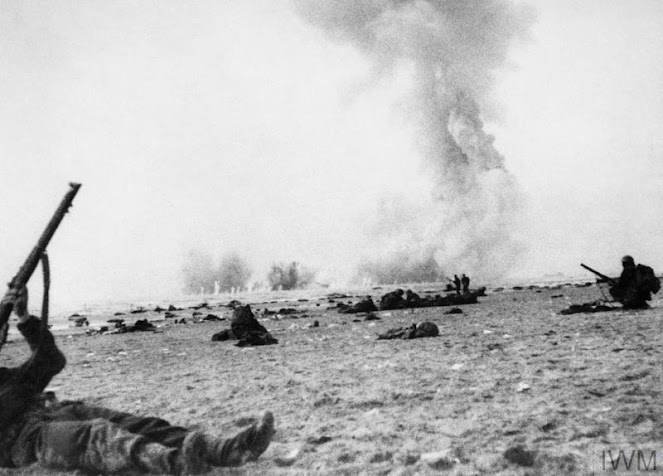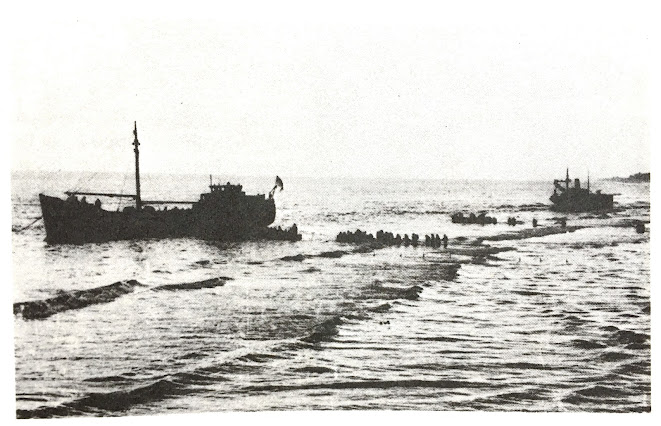The Miracle of Dunkirk by Walter Lord
First Published in 1982 by The Viking Press
British troops under attack by enemy aircraft on the beach at Dunkirk,
20 June 1940. One fires back with his rifle. Photo - IWM, HU93157*
Introduction:
Though the evacuation of British and French troops in late May and early June, 1940, was an operation (i.e., Operation Dynamo) that involved the coordinated efforts of the army, navy and airforce in order to work successfully, it was not a 'combined operation,' nor were Canadians involved as far as I know. However, it was a pivotal, mainly amphibious operation that involved many small crafts (and medium, and large). And if the Brits could have had 100s of various landing crafts and their crews ready at the time they would have been ideally suited for evacuating troops from Dunkirk.
If the Canadians in Combined Operations (C. Ops) had been available in May-June 1940 it would have been a miracle as well. My father was in the first draft of 50 - 60 Canadians to volunteer for C. Ops but they did so beginning in November, 1941. I thought of their significant role often as I read the book by Walter Lord.
Though the evacuation of British and French troops in late May and early June, 1940, was an operation (i.e., Operation Dynamo) that involved the coordinated efforts of the army, navy and airforce in order to work successfully, it was not a 'combined operation,' nor were Canadians involved as far as I know. However, it was a pivotal, mainly amphibious operation that involved many small crafts (and medium, and large). And if the Brits could have had 100s of various landing crafts and their crews ready at the time they would have been ideally suited for evacuating troops from Dunkirk.
If the Canadians in Combined Operations (C. Ops) had been available in May-June 1940 it would have been a miracle as well. My father was in the first draft of 50 - 60 Canadians to volunteer for C. Ops but they did so beginning in November, 1941. I thought of their significant role often as I read the book by Walter Lord.
Please find below a few of the book's highlights, and more:
Jacket painting, "The Little Ships at Dunkirk June 1940," by Norman
Wilkinson, courtesy Trustees of the Imperial War Museum, London
Inside front book cover, a map reveals the setting of the evacuation
The Table of Contents reveals some of the highlights of the book:
The Foreword gives 'the jist' of the story, briefly:
Using a few headings and numbers in the Search Line at the Imperial War Museum I was able to find companion photos for the one above (same location, same foxholes, same men wearing the same helmets) but they had to be purchased. That being said, others re Dunkirk could be found and will appear in a separate post following this entry. ASAP.
Picking up troops direct from the beach seemed to take forever - "loading
ships by the spoonful" was the way one embarkation officer described it.
Above, a trawler and a coaster take aboard men wading out from the shore.
Walter Lord writes:
Lord then adds a lovely line or two about what the Lieutenant experienced in his mind and heart:
"Showers of Cigarettes, Cakes, Candy, and Affection"
The struggles related to the evacuation of over 300,000 British and French troops varied from day to day, as did the ability of German forces to harass and destroy their enemy. For example, each day a motley crew of British officers and organizers were faced with stiff challenges related to getting ships to the right place on time and in one piece. Some days it was easy, other days were hell. Some days were productive for the German air force (Luftwaffe), on others the weather turned sour and planes sat on the ground. "Such is war," my father said about his own ups and downs as a Canadian in Combined Ops.
About changing tides and circumstances Mr. Lord writes the following:
May 28 promised to be an even more productive day for the Luftwaffe. The Begian surrender, the crumbling French defenses, the capture of Calais - all released additional planes. But the weather turned sour; Fliegerkorkorps VIII, responsible for Dunkirk, remained on the ground...
May 29 dawned even worse. A steady drizzle and ceiling only 300 feet. Fliegerkorps VIII steeled itself for another barrage of calls from Goring (who had assured Hitler "that the Luftwaffe could win the battle alone"). But around noon it began to clear up. At 2:00 p.m. Richthofen (Commanding Officer of Fliegerkorps VIII, and "distant cousin of the famous Red Baron") gave the long-delayed orders to attack...
It was no ordinary raid... some 400 aircraft headed for Dunkirk, led by 180 Stukas.
dive-bombs an Allied tank as Hitler strikes west... the Stuka symbolized a
new kind of lightning war - the Blitzkrieg. Photo - Bundesarchiv Bestand
Lord continues:
By 3:00 p.m. they were there. No sign of the RAF. Circling so as to come in from the sea, Corporal Hans Mahnert, a gunner-radio operator flying with Stuka Wing No. 3, looked down on a remarkable sight. Ships were crowded together everywhere. It reminded him, oddly enough, of an old print he had once seen of the English fleet gathered at Trafalgar.
Other more practiced eyes were also scanning the sea. They may have missed the eastern mole (pier, where the Brits loaded many a ship with soldiers) before, but not today. The smoke was blowing inland now, and there - directly below - was a sight no one could overlook. Clustered alongside the mole were a dozen ships. It was hard to imagine a better target...
Walter Lord's next two paragraphs reveal which direction the wind is blowing for the next few pages of his book:
The book is filled with many fine, poignant details related to the unforgettable 'days at Dunkirk' (or Dunkerque). I found the following summative lines in the Foreword:
"To Americans, it has come to mean Mrs. Miniver, little ships, The Snow Goose, escape by sea. To the French, it suggests bitter defeat; to the Germans, opportunity forever lost." (page ix)
Back of book jacket. Painting by Norman Wilkinson
For those who have a full bookshelf...
In my opinion The Miracle of Dunkirk is an exciting, informative, detailed book and I recommend it to others. I was given my clean, hardcover copy for free by a neighbour with a Little Free Library on her front lawn. Excellent!
Please click here to read a short review re another book related (directly and/or indirectly) to Combined Operations. Books: Dieppe: August 19 by Eric Maguire
*re IWM (Imperial War Museum), HU93157, found under the photograph at the top of the page. The photo was taken by an Associated Press photographer or Press Agency photographer (the difference is ?) but no name is provided at IWM.
Unattributed Photos GH




















No comments:
Post a Comment